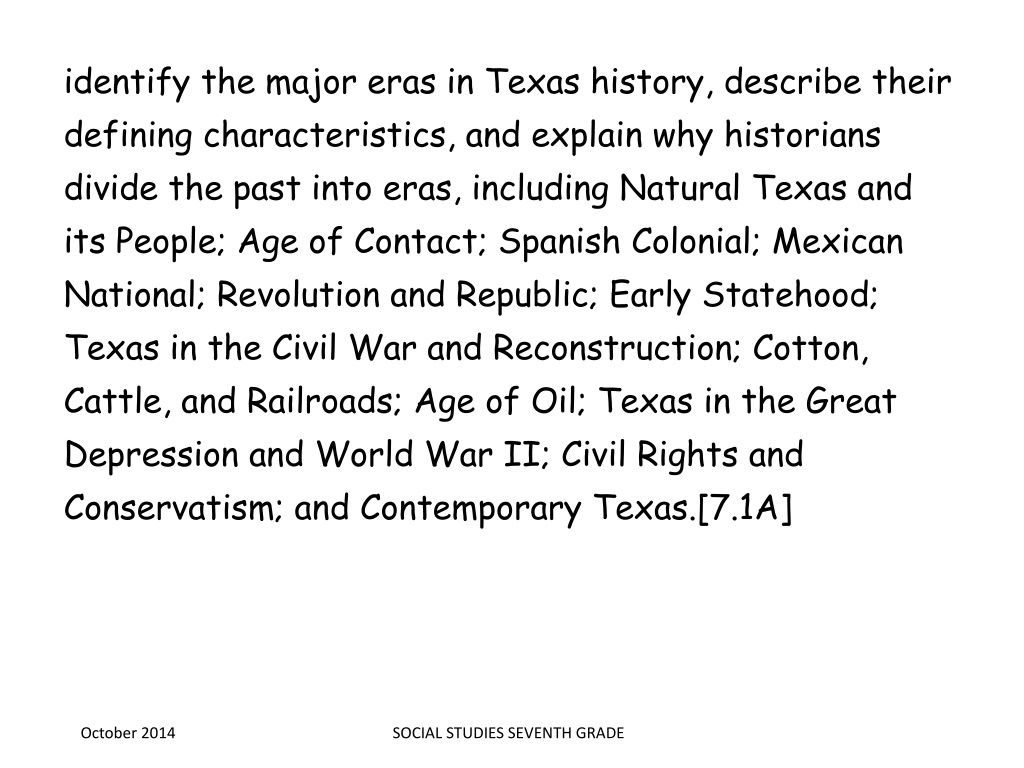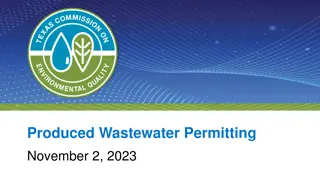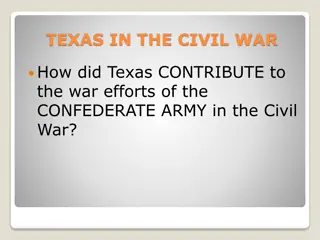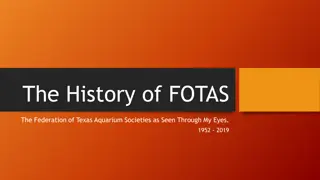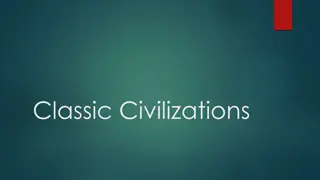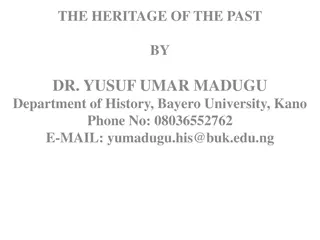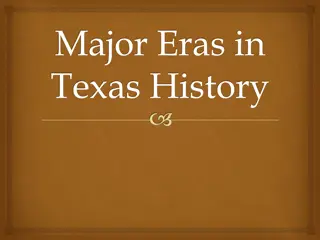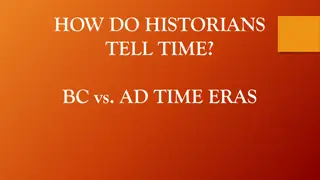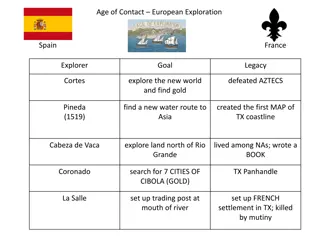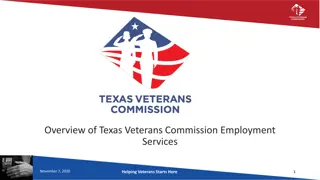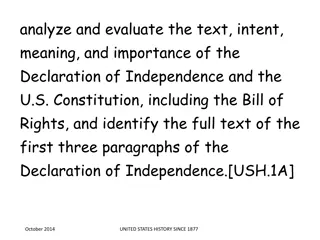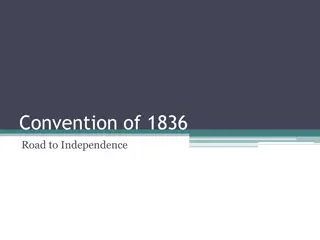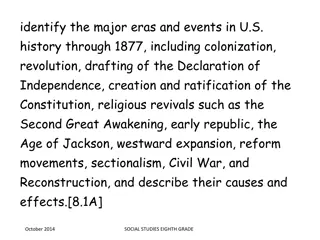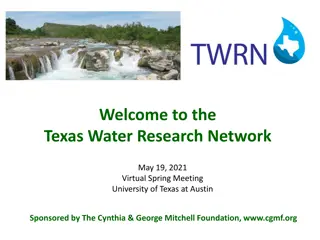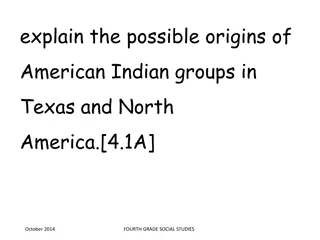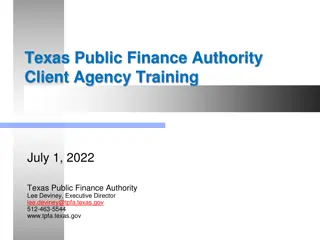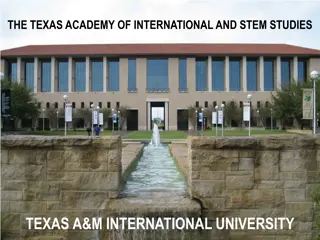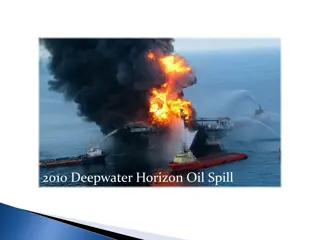Overview of Major Eras in Texas History
Explore the major eras in Texas history, including Natural Texas, Spanish Colonial, Texas Revolution, Age of Oil, and more. Understand the significance of key dates like 1821 and 1836, and compare pre-colonization American Indian cultures. Learn about important figures in European exploration and colonization of Texas.
Download Presentation

Please find below an Image/Link to download the presentation.
The content on the website is provided AS IS for your information and personal use only. It may not be sold, licensed, or shared on other websites without obtaining consent from the author. Download presentation by click this link. If you encounter any issues during the download, it is possible that the publisher has removed the file from their server.
E N D
Presentation Transcript
identify the major eras in Texas history, describe their defining characteristics, and explain why historians divide the past into eras, including Natural Texas and its People; Age of Contact; Spanish Colonial; Mexican National; Revolution and Republic; Early Statehood; Texas in the Civil War and Reconstruction; Cotton, Cattle, and Railroads; Age of Oil; Texas in the Great Depression and World War II; Civil Rights and Conservatism; and Contemporary Texas.[7.1A] October 2014 SOCIAL STUDIES SEVENTH GRADE
apply absolute and relative chronology through the sequencing of significant individuals, events, and time periods.[7.1B] October 2014 SOCIAL STUDIES SEVENTH GRADE
explain the significance of the following dates: 1519, mapping of the Texas coast and first mainland Spanish settlement; 1718, founding of San Antonio; 1821, independence from Spain; 1836, Texas independence; 1845, annexation; 1861, Civil War begins; 1876, adoption of current state constitution; and 1901, discovery of oil at Spindletop.[7.1C] October 2014 SOCIAL STUDIES SEVENTH GRADE
compare the cultures of American Indians in Texas prior to European colonization such as Gulf, Plains, Puebloan, and Southeastern.[7.2A] October 2014 SOCIAL STUDIES SEVENTH GRADE
identify important individuals, events, and issues related to European exploration of Texas such as Alonso lvarez de Pineda, lvar N ez Cabeza de Vaca and his writings, the search for gold, and the conflicting territorial claims between France and Spain.[7.2B] October 2014 SOCIAL STUDIES SEVENTH GRADE
identify important events and issues related to European colonization of Texas, including the establishment of Catholic missions, towns, and ranches, and individuals such as Fray Dami n Massanet, Jos de Escand n, Antonio Margil de Jes s, and Francisco Hidalgo.[7.2C] October 2014 SOCIAL STUDIES SEVENTH GRADE
identify the individuals, issues, and events related to Mexico becoming an independent nation and its impact on Texas, including Texas involvement in the fight for independence, Jos Guti rrez de Lara, the Battle of Medina, the Mexican federal Constitution of 1824, the merger of Texas and Coahuila as a state, the State Colonization Law of 1825, and slavery.[7.2D] October 2014 SOCIAL STUDIES SEVENTH GRADE
identify the contributions of significant individuals, including Moses Austin, Stephen F. Austin, Erasmo Segu n, Mart n De Le n, and Green DeWitt, during the Mexican settlement of Texas.[7.2E] October 2014 SOCIAL STUDIES SEVENTH GRADE
contrast Spanish, Mexican, and Anglo purposes for and methods of settlement in Texas.[7.2F] October 2014 SOCIAL STUDIES SEVENTH GRADE
trace the development of events that led to the Texas Revolution, including the Fredonian Rebellion, the Mier y Ter n Report, the Law of April 6, 1830, the Turtle Bayou Resolutions, and the arrest of Stephen F. Austin.[7.3A] October 2014 SOCIAL STUDIES SEVENTH GRADE
explain the roles played by significant individuals during the Texas Revolution, including George Childress, Lorenzo de Zavala, James Fannin, Sam Houston, Antonio L pez de Santa Anna, Juan N. Segu n, and William B. Travis.[7.3B] October 2014 SOCIAL STUDIES SEVENTH GRADE
explain the issues surrounding significant events of the Texas Revolution, including the Battle of Gonzales, William B. Travis's letter "To the People of Texas and All Americans in the World, " the siege of the Alamo and all the heroic defenders who gave their lives there, the Constitutional Convention of 1836, Fannin's surrender at Goliad, and the Battle of San Jacinto.[7.3C] October 2014 SOCIAL STUDIES SEVENTH GRADE
explain how the establishment of the Republic of Texas brought civil, political, and religious freedom to Texas.[7.3D] October 2014 SOCIAL STUDIES SEVENTH GRADE
identify individuals, events, and issues during the administrations of Republic of Texas Presidents Houston, Lamar, and Jones, including the Texas Navy, the Texas Rangers, Edwin W. Moore, Jack Coffee Hays, Chief Bowles, William Goyens, Mary Maverick, Jos Antonio Navarro, the C rdova Rebellion, the Council House Fight, the Santa Fe Expedition, public debt, and the roles of racial and ethnic groups.[7.4A] October 2014 SOCIAL STUDIES SEVENTH GRADE
analyze the causes of and events leading to Texas annexation.[7.4B] October 2014 SOCIAL STUDIES SEVENTH GRADE
identify individuals, events, and issues during early Texas statehood, including the U.S.-Mexican War, the Treaty of Guadalupe-Hidalgo, population growth, and the Compromise of 1850.[7.4C] October 2014 SOCIAL STUDIES SEVENTH GRADE
explain reasons for the involvement of Texas in the Civil War such as states' rights, slavery, sectionalism, and tariffs.[7.5A] October 2014 SOCIAL STUDIES SEVENTH GRADE
analyze the political, economic, and social effects of the Civil War and Reconstruction in Texas.[7.5B] October 2014 SOCIAL STUDIES SEVENTH GRADE
identify significant individuals and events concerning Texas and the Civil War such as John Bell Hood, John Reagan, Francis Lubbock, Thomas Green, John Magruder and the Battle of Galveston, the Battle of Sabine Pass, and the Battle of Palmito Ranch.[7.5C] October 2014 SOCIAL STUDIES SEVENTH GRADE
identify significant individuals, events, and issues from Reconstruction through the beginning of the 20th century, including the factors leading to the expansion of the Texas frontier, the effects of westward expansion on American Indians, the buffalo soldiers, and Quanah Parker.[7.6A] October 2014 SOCIAL STUDIES SEVENTH GRADE
identify significant individuals, events, and issues from Reconstruction through the beginning of the 20th century, including the development of the cattle industry from its Spanish beginnings and the myths and realities of the cowboy way of life.[7.6B] October 2014 SOCIAL STUDIES SEVENTH GRADE
describe and compare the impact of the Progressive and other reform movements in Texas in the 19th and 20th centuries such as the Populists, women's suffrage, agrarian groups, labor unions, and the evangelical movement of the late 20th century.[7.6C] October 2014 SOCIAL STUDIES SEVENTH GRADE
explain the political, economic, and social impact of the agricultural industry and the development of West Texas resulting from the close of the frontier.[7.6D] October 2014 SOCIAL STUDIES SEVENTH GRADE
explain the political, economic, and social impact of the oil industry on the industrialization of Texas.[7.7A] October 2014 SOCIAL STUDIES SEVENTH GRADE
define and trace the impact of "boom- and-bust" cycles of leading Texas industries throughout the 20th and early 21st centuries such as farming, oil and gas production, cotton, ranching, real estate, banking, and computer technology.[7.7B] October 2014 SOCIAL STUDIES SEVENTH GRADE
describe and compare the impact of the Progressive and other reform movements in Texas in the 19th and 20th centuries such as the Populists, women's suffrage, agrarian groups, labor unions, and the evangelical movement of the late 20th century.[7.7C] October 2014 SOCIAL STUDIES SEVENTH GRADE
describe and compare the civil rights and equal rights movements of various groups in Texas in the 20th century and identify key leaders in these movements, including James L. Farmer Jr., Hector P. Garcia, Oveta Culp Hobby, Lyndon B. Johnson, the League of United Latin American Citizens (LULAC), Jane McCallum, and Lulu Belle Madison White.[7.7D] October 2014 SOCIAL STUDIES SEVENTH GRADE
analyze the political, economic, and social impact of major events, including World War I, the Great Depression, and World War II, on the history of Texas.[7.7E] October 2014 SOCIAL STUDIES SEVENTH GRADE
analyze the political, economic, and social impact of major events in the latter half of the 20th and early 21st centuries such as major conflicts, the emergence of a two-party system, political and economic controversies, immigration, and migration.[7.7F] October 2014 SOCIAL STUDIES SEVENTH GRADE
create and interpret thematic maps, graphs, charts, models, and databases representing various aspects of Texas during the 19th, 20th, and 21st centuries.[7.8A] October 2014 SOCIAL STUDIES SEVENTH GRADE
analyze and interpret geographic distributions and patterns in Texas during the 19th, 20th, and 21st centuries.[7.8B] October 2014 SOCIAL STUDIES SEVENTH GRADE
locate the Mountains and Basins, Great Plains, North Central Plains, and Coastal Plains regions and places of importance in Texas during the 19th, 20th, and 21st centuries such as major cities, rivers, natural and historic landmarks, political and cultural regions, and local points of interest.[7.9A] October 2014 SOCIAL STUDIES SEVENTH GRADE
compare places and regions of Texas in terms of physical and human characteristics.[7.9B] October 2014 SOCIAL STUDIES SEVENTH GRADE
analyze the effects of physical and human factors such as climate, weather, landforms, irrigation, transportation, and communication on major events in Texas.[7.9C] October 2014 SOCIAL STUDIES SEVENTH GRADE
identify ways in which Texans have adapted to and modified the environment and analyze the positive and negative consequences of the modifications.[7.10A] October 2014 SOCIAL STUDIES SEVENTH GRADE
explain ways in which geographic factors such as the Galveston Hurricane of 1900, the Dust Bowl, limited water resources, and alternative energy sources have affected the political, economic, and social development of Texas.[7.10B] October 2014 SOCIAL STUDIES SEVENTH GRADE
analyze why immigrant groups came to Texas and where they settled.[7.11A] October 2014 SOCIAL STUDIES SEVENTH GRADE
analyze how immigration and migration to Texas in the 19th, 20th, and 21st centuries have influenced Texas.[7.11B] October 2014 SOCIAL STUDIES SEVENTH GRADE
analyze the effects of the changing population distribution and growth in Texas during the 20th and 21st centuries and the additional need for education, health care, and transportation.[7.11C] October 2014 SOCIAL STUDIES SEVENTH GRADE
describe the structure of the population of Texas using demographic concepts such as growth rate and age distribution.[7.11D] October 2014 SOCIAL STUDIES SEVENTH GRADE
explain economic factors that led to the urbanization of Texas.[7.12A] October 2014 SOCIAL STUDIES SEVENTH GRADE
trace the development of major industries that contributed to the urbanization of Texas such as transportation, oil and gas, and manufacturing.[7.12B] October 2014 SOCIAL STUDIES SEVENTH GRADE
explain the changes in the types of jobs and occupations that have resulted from the urbanization of Texas.[7.12C] October 2014 SOCIAL STUDIES SEVENTH GRADE
analyze the impact of national and international markets and events on the production of goods and services in Texas such as agriculture, oil and gas, and computer technology.[7.13A] October 2014 SOCIAL STUDIES SEVENTH GRADE
analyze the impact of economic concepts within the free enterprise system such as supply and demand, profit, government regulation, and world competition on the economy of Texas.[7.13B] October 2014 SOCIAL STUDIES SEVENTH GRADE
analyze the impact of significant industries in Texas such as oil and gas, aerospace, medical, and computer technologies on local, national, and international markets.[7.13C] October 2014 SOCIAL STUDIES SEVENTH GRADE
identify how the Texas Constitution reflects the principles of limited government, republicanism, checks and balances, federalism, separation of powers, popular sovereignty, and individual rights.[7.14A] October 2014 SOCIAL STUDIES SEVENTH GRADE
compare the principles and concepts of the Texas Constitution to the U.S. Constitution, including the Texas and U.S. Bill of Rights.[7.14B] October 2014 SOCIAL STUDIES SEVENTH GRADE
describe the structure and functions of government at municipal, county, and state levels.[7.15A] October 2014 SOCIAL STUDIES SEVENTH GRADE
identify major sources of revenue for state and local governments such as property tax, sales tax, and fees.[7.15B] October 2014 SOCIAL STUDIES SEVENTH GRADE
